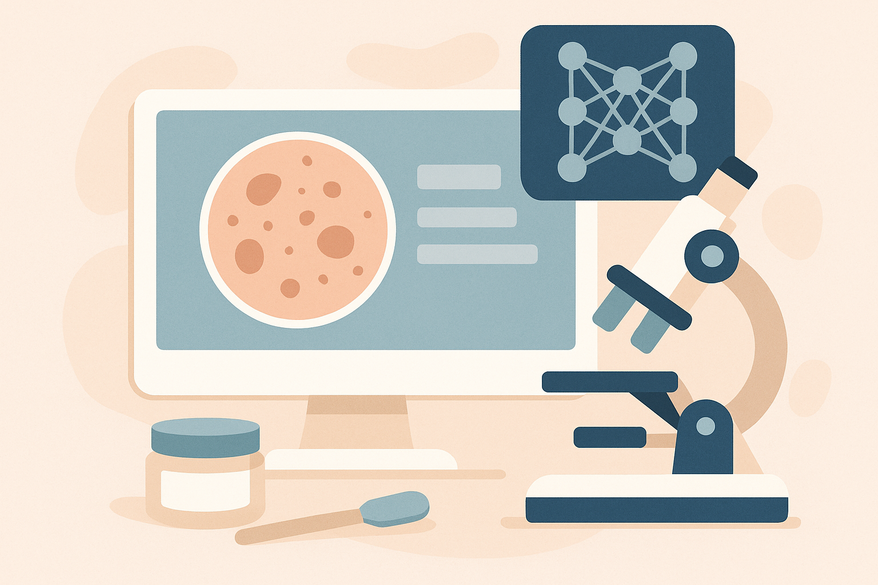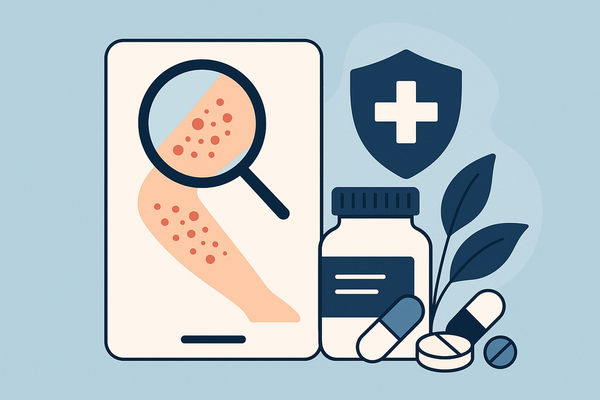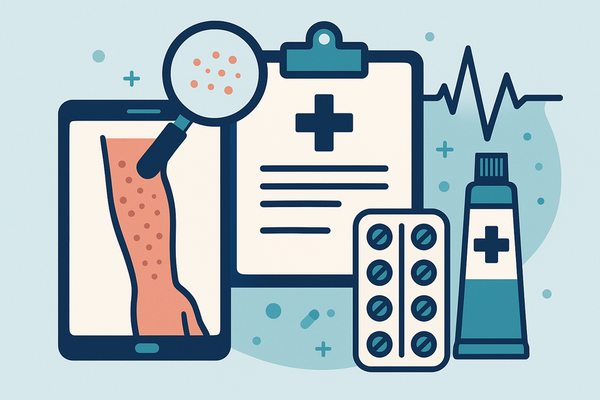Machine Learning in Skin Analysis: AI's Role in Diagnosing Rashes and Skin Conditions
Explore how machine learning in skin analysis transforms dermatology by improving diagnostic accuracy, speeding up assessments, and assisting areas lacking specialists.

Estimated reading time: 10 minutes
Key Takeaways
- Advanced image analysis: AI detects subtle patterns in color, texture, and morphology.
- Efficiency gains: Automated workflows reduce time-to-diagnosis from days to minutes.
- Robust training: Large, diverse datasets and augmentation combat overfitting and bias.
- Practical adoption: Mobile apps and EHR-integrated support are reshaping patient care.
- Ongoing oversight: Expert dermatological input remains crucial to address data quality and ethical concerns.
Table of Contents
- Background on Machine Learning in Skin Analysis
- How Machine Learning Diagnoses Skin Conditions
- Detailed Analysis of Skin Conditions and Rashes
- Technical Insights
- Practical Applications and Future Trends
- Conclusion & Additional Resources
Background on Machine Learning in Skin Analysis
Definition of Machine Learning in Healthcare
Machine learning (ML) is a subset of artificial intelligence that enables systems to learn patterns from data and make decisions with minimal human intervention. In healthcare, ML bridges complex data analysis and clinical decision-making.
ML Applications Across Healthcare Verticals
- Radiology: Automated tumor detection in MRI and CT scans.
- Pathology: Digital slide analysis to identify cancerous cells.
- Patient Monitoring: Predictive alerts based on vital sign trends.
- Predictive Analytics: Forecasting disease outbreaks and readmissions.
Historical Evolution of AI Diagnostics
- 1970s–1980s: Rule-based expert systems with predefined logic.
- 1990s–2000s: Early neural networks for pattern recognition.
- 2010s–Present: Deep learning architectures (CNNs, ResNet, Inception) transforming image analysis.
Dermatology has shifted from manual dermoscopic photo review to automated analysis. Modern ML systems extract features from skin images to alert clinicians about early signs of melanoma, eczema, and rashes.
How Machine Learning Diagnoses Skin Conditions
Data Collection
Reliable AI models require large-scale, annotated datasets:
- Over 1 million clinical and dermoscopic photos.
- Expert dermatologists label images to establish ground truth.
- Diverse conditions: benign moles, malignant lesions, various rashes.
machine learning dermatology applications • MDPI systematic review
Preprocessing
Before training, images undergo standardization and augmentation:
- Resizing to uniform dimensions for batch processing.
- Color normalization to correct lighting differences.
- Hair and artifact removal to highlight skin features.
- Augmentation (rotation, flipping, brightness shifts) to expand diversity and combat overfitting.
Model Training
Convolutional Neural Networks (CNNs) power most skin-analysis systems:
- Convolutional layers extract feature maps of texture, edges, and color gradients.
- Pooling layers downsample data to reduce computation.
- Fully connected layers perform final classification.
Transfer learning frameworks like ResNet and Inception are fine-tuned on dermatology datasets to boost accuracy and reduce training time.
MDPI systematic review • machine learning dermatology applications
Pattern Detection & Classification
AI algorithms learn to identify key morphological markers:
- Asymmetry and border irregularity for melanoma screening.
- Color variation for inflammatory vs infectious rashes.
- Shape and size metrics to differentiate benign vs malignant lesions.
Detailed Analysis of Skin Conditions and Rashes
Case Study A – SkinVision App
SkinVision leverages a CNN trained on over 1 million images to evaluate mole and lesion risk. Users receive a risk score (low, medium, high) and recommendations to seek dermatologist consultation when necessary. Real-world feedback shows faster peace of mind and earlier medical review.
machine learning dermatology applications
Case Study B – Aysa AI App
In a 700-patient clinical study, Aysa delivered:
- Mean top-1 sensitivity: 71% overall.
- Higher sensitivity for infestations and inflammatory conditions.
- Lower sensitivity for malignancies, prompting further validation.
Patients can also try Rash Detector for instant evaluations and a sample report:

AI vs Traditional Exams
- Volume: AI processes thousands of images in seconds; manual review takes minutes to hours.
- Metrics:
- Sensitivity and specificity comparable to expert dermatologists.
- Time-to-diagnosis reduced from days to minutes.
- Improved early detection with consistent analysis.
Technical Insights
Workflow Breakdown
Data Annotation: Standardized labeling by board-certified dermatologists with inter-rater reliability checks.
Model Training: Dataset splits (training, validation, testing), hyperparameter optimization, cross-validation.
Validation & Testing: ROC AUC metrics, confusion matrices, and external validation on diverse skin types.
machine learning dermatology applications • JMIR Dermatology case study
Key Challenges & Mitigations
- Image Quality Variability: Implement pipelines for lighting and resolution standardization.
- Dataset Bias: Collect multi-ethnic skin types and maintain class balance.
- Label Noise: Use consensus labeling and expert adjudication.
Role of Dermatological Expertise
- Defining annotation protocols.
- Validating AI outputs against real-world diagnoses.
- Ensuring models address clinically relevant features.
Practical Applications and Future Trends
Current Clinical & Consumer Applications
- Home-use mobile apps offer risk assessments and triage guidance.
- Clinical Decision Support integrated into EHRs assists with complex diagnoses.
- Personalized skincare recommendations based on individual profiles.
Explore comprehensive skin monitoring tools in our skin tracking tools guide.
Emerging Trends & Research Directions
- Real-time diagnostics via on-device CNN inference and edge computing.
- Teledermatology platforms for pre-consult triage in remote areas.
- Multi-modal AI combining images with genomics and patient history.
- Regulatory and privacy considerations: FDA approvals, HIPAA compliance, data encryption.
Conclusion & Additional Resources
Machine learning in skin analysis delivers:
- Enhanced diagnostic accuracy through objective pattern recognition.
- Significant time savings for patients and clinicians.
- Potential for early detection and remote triage.
Limitations persist:
- Dependency on high-quality, representative images.
- Risk of dataset bias without diverse training data.
- Continued necessity for expert oversight.
AI should support—not replace—professional medical advice. Always consult licensed dermatologists and explore emerging research.
Further Reading:
• MDPI systematic review on AI in dermatology
• Dermatology Times case studies
• JMIR Dermatology white papers
Disclaimer: AI tools assist but do not replace clinical judgment. Seek professional evaluation for diagnosis and treatment.
FAQ
- How does AI improve rash diagnosis?
AI uses convolutional neural networks to analyze color, shape, and texture patterns, increasing sensitivity and specificity. - Are these tools safe and accurate?
Most platforms achieve performance comparable to expert dermatologists, but accuracy depends on image quality and dataset diversity. - Can I rely on mobile apps for medical decisions?
Mobile apps provide preliminary assessments and triage guidance; always confirm with a licensed professional. - What are common challenges in AI dermatology?
Challenges include image variability, dataset bias, and annotation consistency—mitigated by expert oversight and robust preprocessing.





